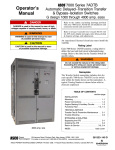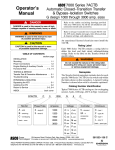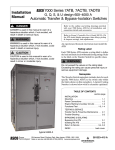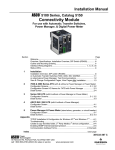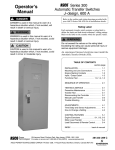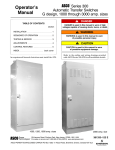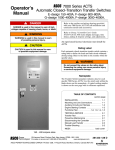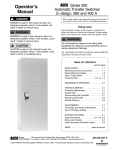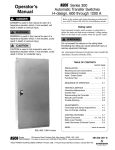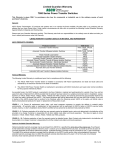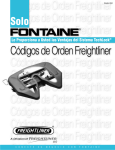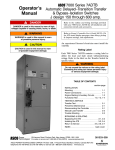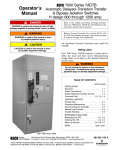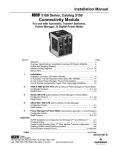Download Emerson 7ATB Power Supply User Manual
Transcript
Operator’s Manual 7000 Series 7ATB Automatic Transfer & Bypass–Isolation Switches G design 1000 through 4000 amp. sizes DANGER is used in this manual to warn of high voltages capable of causing shock, burns, or death. WARNING is used in this manual to warn of possible personal injury. Refer to the outline and wiring drawings provided with your 7000 Series ATB for all installation and connection details and accessories. Refer to Group 5 Controller User’s Guide 381333–126 for ATS status display messages, time delays, pickup & dropout settings, and adjustments. An experienced licensed electrician must install the 7ATB. Rating Label CAUTION is used in this manual to warn of possible equipment damage. Each 7000 Series 7ATB contains a rating label to define the loads and fault circuit withstand/closing ratings. Refer to the label on the Transfer Switch for specific values. Do not exceed the values on the rating label. Exceeding the rating can cause personal injury or serious equipment damage. Nameplate The Transfer Switch nameplate includes data for each specific 7000 Series ATB. Use the switch only within the limits shown on this nameplate. A typical Catalog Number is shown below with its elements explained: TABLE OF CONTENTS section-page INSTALLATION Mounting . . . . . . . . . . . . . . . . . . . . . . . . . . . . . 1-1 Power Connections . . . . . . . . . . . . . . . . . . . . 1-2 Engine Starting & Auxiliary Circuits . . . . . . 1-2 Functional Test . . . . . . . . . . . . . . . . . . . . . 1-3, 1-4 TESTING & SERVICE Transfer Test . . . . . . . . . . . . . . . . . . . . . . . . . . Preventive Maintenance . . . . . . . . . . . . . . . . Disconnecting the Controller . . . . . . . . . . . . Manual Load Transfer . . . . . . . . . . . . . . . . . . Trouble-Shooting . . . . . . . . . . . . . . . . . . . . . . 4000 amp. size 2-1 2-1 2-1 2-2 2-2 BYPASSING & ISOLATING Bypassing the ATS . . . . . . . . . . . . . . . . . . . . 3-1 Isolating the ATS . . . . . . . . . . . . . . . . . . . . . . 3-2 Return to Service . . . . . . . . . . . . . . . . . . . 3-3, 3-4 INDEX . . . . . . . . . . . . . . . . . . . . . . . . . back cover 50 Hanover Road, Florham Park, New Jersey 07932–1591 USA For sales or service call 1 800 800–2726 (ASCO) www.ascopower.com ASCO POWER TECHNOLOGIES CANADA PO Box 1238, 17 Airport Road, Brantford, Ontario, Canada N3T 5T3 381333–132 F Catalog Number Identification G7ATB Neutral A – solid B – switching C – overlapping blank – none C Phase Poles 2 – single Ø 3 – three Ø Typical 7000 Series ATB catalog no. for overlapping neutral, 3 pole, 4000 amp., 480 V, in Type 1 enclosure: 3 4000 Amperes 1000 1200 1600 2000 2600 3000 4000 N 5 Voltage A 115 B 120 C 208 D 220 E 230 F 240 G 277 H 380 Status Lights & Engine Control J 400 K 415 L 440 M 460 N 480 P 550 Q 575 R 600 C Controller 5 – standard 5X – if accessories ordered Enclosure C – type 1 F – type 3R G – type 4 L – type 12 blank – open type Transfer Control & Lights Bypass Handle Group 5 Controller Isolation Handle Transfer Switch G7ATB 4000 A with the lower doors open (transfer switch shown) SECTION 1 INSTALLATION Remove Shipping Brackets / Angles from the Transfer Switch The ASCO 7000 Series Automatic Transfer & Bypass–Isolation Switch (ATB) consists of an upper bypass–isolation switch, a lower transfer switch, a monitoring and transfer controller, and door–mounted controls. The ATB is factory wired and tested. Installation requires removal of the shipping skid then securing the enclosure to the supporting foundation. Open the lower front door(s). The Transfer Switch carriage is secured to the frame for shipment. Remove the three or four shipping brackets or L–angles (1 upper left, 1 upper right, 1 lower right, or 2 lower on 4000 A). Remove the Shipping Skid To prevent serious damage, remove 3 shipping angles from the transfer switch carriage. Do not turn the Isolation Handle until they are removed! Open the front lower door and remove the two front lag screws securing the enclosure to the wood skid. Next remove the rear lower panel and remove the two rear lag screws securing the enclosure to the wood skid. Supporting Foundation The supporting foundation for the enclosure must be level and straight. Allow at least 35 inches in front of the enclosure for draw out of the Transfer Switch. Refer to the enclosure outline drawing included with the ATB for all mounting details including door opening space. If bottom cable entry is used, the foundation must be prepared so that the conduit stubs are located correctly. Refer to the appropriate enclosure outline drawing for specified cable entrance area and location. Provide cable bending space and clearance to live metal parts. When a concrete floor is poured, use interlocking conduit spacer caps or a wood or metal template to maintain proper conduit alignment. remove 3 or 4 shipping brackets ( L–angles) Mounting Figure 1-1. On 1000–3000 A remove three shipping L–angles. Refer to the enclosure outline drawing furnished with this switch and mount the 7000 Series ATB according to the details and instructions shown on the drawing. remove 2 upper shipping brackets remove 2 lower shipping brackets Figure 1-2. 4000 A remove four shipping L–angles. 1---1 INSTALLATION (continued) Bus Connections If bus connection is used, use SAE grade 5 hardware to connect bus to appropriate terminal plates on bypass switching device. Wipe off bus surfaces before they are joined. If bus is dirty, gently clean surfaces with a non-flammable solvent. Avoid touching cleaned surfaces. De–energize the conductors before making any line or auxiliary circuitry connections. Be sure that Normal and Emergency line connections are in proper phase rotation. Place engine generator starting control in the OFF position. Make sure engine generator is not in operation. Testing Power Conductors Do not connect the power conductors to the ATB until they are tested. Installing power cables in conduit, cable troughs, and ceiling-suspended hangers often requires considerable force. The pulling of cables can damage insulation and stretch or break the conductor’s strands. For this reason, after the cables are pulled into position, and before they are connected they should be tested to verify that they are not defective or have been damaged during installation. Do not breathe cleaning solvent vapors. Use SAE grade 5 hardware and tighten the bolted joints to the torque specified in Table 2-1. The reliability of the connection depends on how clean and how tight the joint is. Table 2-1. Tightening torque values for bolted joints. Bolt Diameter Recommended (Grade 5 hardware) Tightening Torque in inches in foot pounds 5/16 12 3/8 20 1/2 50 5/8 95 Protect the switch from construction grit and metal chips to prevent malfunction or shortened life of the 7ATB switch. Connecting Power Conductors A Wiring Diagram is furnished with the ATB. All wiring must be made in accordance with the local codes. After the power cables have been tested, connect them to the appropriate terminal lugs on the Bypass Switch as shown on the wiring diagram provided with this ATB. Make sure that the lugs provided are suitable for use with the cables being installed. Standard terminal lugs are solderless screw type and will accept the wire sizes listed on the drawings provided with the ATB. Be careful when stripping insulation from conductors; avoid nicking or ringing the conductor. Remove surface oxides from conductors by cleaning with a wire brush. Follow conductor manufacturer’s instructions when aluminum conductor is used. Apply joint compound to conductor, then carefully wipe away excess compound. Tighten the cable lugs to the torque specified on the rating label. Harnesses All internal connections are made at the factory. The bypass switch, transfer switch, and control panel are joined together by an interconnecting wire harness. The disconnect plugs are already engaged on enclosed switches. For open–type switches, the plugs must be engaged after installation is completed. Align harness plugs with sockets in the control and push them together until they are secure. Engine Starting Contacts and Auxiliary Circuits The engine control contact signal connections and auxiliary circuits are located on terminal block TB as shown on the Wiring Diagram provided with the ATB. Connect the signal wires to the appropriate terminals. Be sure that the Normal and Emergency power connections are in proper phase rotation. 1---2 INSTALLATION (continued) Transfer Switch Connected To Normal observe these lights Transfer Control Transfer Switch Connected Retransfer Transfer Test To Delay HOLD FOR Bypass (15 SECONDS ) Emergency GREEN RED Normal Source Accepted Emergency Source Accepted GREEN RED Figure 1-2. Standard controls and indicators. Close the normal source circuit breaker. The Transfer Switch 1 Connected To Normal and the Normal Source Accepted lights should come on. Functional Test Read all instructions on the Wiring Diagrams and labels affixed to the ATB. Note the control features that are provided and review their operation before proceeding. Use an accurate voltmeter to check phase to phase and 2 phase to neutral voltages present at the transfer switch normal source terminals. After installing the ATB check the following: – Bypass Handle should be in the NORMAL position. – Isolation Handle should be in the CONN position. – TS transfer switch Normal contacts should be CLOSED (Emergency contacts should be OPEN) Close the emergency source circuit breaker. (Start generator, if necessary.) The Transfer 3 Switch Connected To Normal & Emergency Source Accepted lights should come on. If handles are not in correct positions, follow instructions for Bypassing and Isolating the automatic transfer switch in Section 3. Do not force the handles. Electrical interlocks prevent a wrong sequence of operation. Use an accurate voltmeter to check phase to phase and 4 phase to neutral voltages present at the transfer switch emergency source terminals.* 1 – Voltage Checks First check nameplate on transfer switch; rated voltage must be the same as normal and emergency line voltages. Use a phase rotation meter to check phase rotation of emer5 gency source; it must be the same as the normal source. Use extreme caution when using a meter to measure voltages. Do not touch power terminals; shock, burns, or death could result ! Perform steps 1–6 at the right. Observe the status lights. See Figure 1–2. Q Black square means light is on. S White square means light is off. Shut down the engine–generator, if applicable. The Emergency Source Accepted light should 6 go off. Then put the starting control selector switch (on the generator set) in the automatic position. Close enclosure door. * If necessary, adjust voltage regulator on generator per the manufacturer’s recommendations. The ATB will respond only to rated voltage specified on the nameplate. Now continue to 2 – Electrical Operation on next page. 1---3 A B C INSTALLATION (continued) Transfer Switch Connected To Normal observe these lights Transfer Control Transfer Switch Connected Retransfer Transfer Test To Delay HOLD FOR Bypass (15 SECONDS ) Emergency GREEN RED Normal Source Accepted Emergency Source Accepted GREEN RED operate this switch Figure 1-3. Standard controls and indicators. 2 – Electrical Operation The Transfer Switch Connected 1 to Normal and Normal Source Accepted lights should be on. This procedure checks electrical operation of the ATS. Be sure to close the enclosure door before proceeding to prevent personal injury in case of electrical system fault. Turn and hold Transfer Control switch clockwise to Transfer Test until the engine starts 2 and runs (within 15 sec.). The Emergency Source Accepted light should come on. Transfer Test The ATS should still be bypassed. Both normal and emergency sources must be available and the emergency source generator (if used) must be capable of being started; put engine starting control in automatic position. The Transfer Switch Connected to Normal light and the Normal Source Accepted light should be on. 1. Transfer switch will operate to the Emergency position after Feature 2B time delay. The 3 Transfer Switch Connected To Emergency light should come on and Load Connected to Normal light goes off. Transfer switch will operate back to Normal position after Feature 3A time delay. For immediate retransfer turn Transfer Control counterclockwise to 4 Retransfer Delay Bypass. The Transfer Switch Connected To Normal light should come on; Transfer Switch Connected to Emergency light should go off. Turn the Isolation Handle counterclockwise to the TEST position. NOTE: The engine generator may be signalled to start while turning the Isolation Handle. If emergency source is available, the ATS may operate to the emergency position. If it does, operate Retransfer Delay Bypass switch. 2. Perform steps 1–5 at right. Observe the status lights. Q Black square means light is on. S White square means light is off. 3. Turn the Isolation Handle clockwise to the CONN (connected) position. 4. Push in the Bypass Handle and turn it counterclockwise to the OPEN position. The engine–generator will stop after the Feature 2E time delay 5 (unloaded running engine cooldown). The Emergency Source Accepted light should go off. This completes the Functional Test of the ATB. 1---4 SECTION 2 TESTING & SERVICE TRANSFER TEST REPLACEMENT PARTS Test the Automatic Transfer Switch portion of the 7000 Series ATB at least once a month. This procedure checks the electrical operation of the Transfer Switch and Controller. Put the engine–generator starting control (at the engine–generator set) in automatic mode. In the following test the generator will start, the load will be transferred to the Emergency source, then back to the Normal source. An interruption to the load will occur, unless the the Transfer Switch contacts are bypassed before the test. See pages 3–1 and 3–2 for bypassing & isolating instructions if no interruption of load is required. Replacement parts are available in kit form. When ordering parts provide the Serial No., Bill of Material No. (BOM), and Catalog No. from the transfer switch nameplate. For service call ASCO Services at 1–800–800–2726. DISCONNECTING THE CONTROLLER The harness disconnect plugs are furnished for repair purposes only and should not have to be unplugged. If the controller must be isolated, follow these steps: Bypass–Isolation Switch is energized! Do not touch isolation contact fingers; shock, burns, or death could result! Be sure to close the enclosure door before proceeding to prevent personal injury in case of electrical system fault. Disconnecting the Plugs 1. Bypass and Isolate the Automatic Transfer Switch. Perform the five–step Electrical Operation – Transfer Test procedure on page 1–4. 2. Open the upper enclosure door. 3. Separate the two quick disconnect plugs by squeezing the latches. Do not pull on the harness wires. PREVENTIVE MAINTENANCE Reasonable care in preventive maintenance will insure high reliability and long life for the 7000 Series ATB. An annual preventive maintenance program is recommended. Reconnecting the Plugs 1. The ATS should be still bypassed and isolated. 2. The two harness plugs and sockets are keyed. Carefully align the plugs with the sockets and press straight in until the latches click. ASCO Services, Inc. (ASI) is ASCO Power Technologies’ national service organization. ASI can be contacted at 1–800–800–2726 for information on preventive maintenance agreements. 3. Close the enclosure doors. 4. Follow Return to Service instructions on page 3–3. Checklist for Yearly Inspection Hazardous voltage capable of causing shock, burns, or death is used in this switch. Deenergize both Normal – Emergency power sources before performing inspections! S Clean the ATB enclosure. Brush and vacuum away any excessive dust accumulation. Remove any moisture with a clean cloth. S Check the transfer switch contacts. Remove transfer switch barriers and check the condition of the contacts. Replace contacts when pitted or worn excessively. Reinstall the barriers carefully. S Maintain transfer switch lubrication. If switch is subjected to severe dust or abnormal operating conditions, renew factory lubrication on all movements and linkages. Relubricate solenoid operator if TS coil is replaced. Don’t use oil; order lubrication kit 75-100. S Check all cable connections & retighten them. 2---1 TESTING & SERVICE (continued) TROUBLE-SHOOTING Hazardous voltage capable of causing shock, burns, or death is used in this switch. Do not touch the power or load terminals of the bypass switch or transfer switch! Note any optional accessories that may be furnished on the ATB and review their operation. Refer to any separate drawings and/or instructions that may be packed with the ATB. Table 2-1. Trouble-Shooting Checks. PROBLEM Engine–generator set does not start when the Transfer Control switch is turned and held in Transfer Test position or when normal source fails. CHECK IN NUMERICAL SEQUENCE 1 2 OPERATION GEN-SET Hold Transfer Test switch 15 Starting control must be in the seconds or the outage must automatic position. Batteries be long enough to allow for must be charged and Feature 1C time delay plus connected. Check wiring to engine cranking and starting. engine starting contacts. 3 VOLTAGE – Transfer switch does not transfer the load to the emergency source after the engine–generator set starts. Wait for Feature 2B time delay Generator output circuit breaker must be closed. to time out. Generator frequency must be at least 95% of nominal (57 Hz for a 60 Hz system.) * Voltmeter should read at least 90% of nominal phase to phase voltage between transfer switch terminals EA & EC (or EL1 & EL2 for 2 pole)* Transfer switch does not transfer the load to normal source when normal returns or when the Transfer Control switch is released. Wait for Feature 3A time delay to time out. Voltmeter should read at least 90% of nominal phase to phase voltage between transfer switch terminals NB & NC, NC & NA, & NA & NB (or NL1 & NL2 for 2 pole). Engine–generator-set does not stop after load retransfer to the normal source. Wait for Feature 2E time delay Starting control must be in the to time out. automatic position. – – * These are factory settings. Refer to Controller’s User’s Guide. If the problem is isolated to circuits on the controller or the transfer switch, call your local ASCO Power Technologies sales office or ASI: in the United States, call 1–800–800–2726. Furnish the Serial No., Catalog No., and Bill of Material (BOM) No. from the transfer switch nameplate. MANUAL LOAD TRANSFER MAINTENANCE HANDLE This procedure manually transfers load to other source if the Transfer Switch or Controller are out of service. Bypass and isolate the Transfer Switch before using the maintenance handle! See pages 3–1 and 3–2. Remove the maintenance handle after using it and store it on the frame. Close enclosure doors to prevent personal injury in case of electrical system fault. 1. Be sure that the Bypass Handle is CLOSED on either Emergency or Normal (see page 3–1). Turn counterclockwise to Emergency. 2. Be sure that the Isolation Handle is in the TEST or ISOLATE position (see page 3–2). Turn clockwise to Normal. 3. Turn the Bypass Handle counterclockwise to OPEN the Bypass Switch. Then Bypass to the other source (see page 3–1). slide hub onto shaft 2---2 Grasp handle firmly insert handle into hole SECTION 3 BYPASSING & ISOLATING BYPASSING THE ATS* This procedure explains how to Bypass the closed automatic transfer switch contacts. Bypassing is required before the ATS can be tested or isolated. The Bypass Handle must be in the OPEN position (green indicator) and the Isolation Handle must be in the CLOSED position (window). See Figures 3–1, 3–2, and 3–3. You can only bypass to the same source that the Transfer Switch is connected. Solenoid interlock prevents incorrect operation. 1. 2. Observe which Transfer Switch Connected To light is on (Normal or Emergency) on the door. This is the position of the automatic transfer switch. Bypass to the same source as connected to transfer switch as follows (select Normal or Emergency). Indicator shows: Indicator shows: yellow O EMERGENCY CLOSED when ATS is bypassed to Emergency or green O OPEN when the ATS is not bypassed. yellow O NORMAL CLOSED when ATS is bypassed to Normal Source. To Bypass Normal push in handle all the way & turn it clockwise.* To Bypass Emergency pull out handle all the way & turn it clockwise.* Figure 3–1. Bypass Handle and position indicators. To Bypass Normal Source* To Bypass Emergency Source* (Load connected to Normal Source) The Transfer Switch Connected To Normal light is on and Transfer Switch Connected To Emergency light is off. (Load connected to Emergency Source) The Transfer Switch Connected To Emergency light is on and Transfer Switch Connected To Normal light is off. Push in* the Bypass Handle all the way, then turn it clockwise until Bypass Switch Position shows CLOSED on NORMAL (yellow indicator). The red light Unit Not In Automatic will flash. Pull out* the Bypass Handle all the way, then turn it clockwise until Bypass Switch Position shows CLOSED on EMERGENCY (yellow indicator). The red light Unit Not In Automatic will flash. Push in Bypass Handle & turn it clockwise. Bypass Switch Pull out Bypass Handle & turn it clockwise. E L Bypass Switch E L N N ATS ATS Figure 3–2. Bypass to Normal. Figure 3–3. Bypass to Emergency. The automatic transfer switch can now be put in the TEST or OPEN position. See ISOLATING on page 3–2. * NOTE: When Accessory 66A (reversed Normal & Emergency connections) is specified, the handle push–pull operation is reversed. Follow instructions on the door. 3---1 BYPASSING & ISOLATING (continued) ISOLATING THE ATS Isolating is required before any service work can be performed on the automatic transfer switch (ATS). Refer to Figures 3–4, 3–5, 3–6, and 3–7. CONN TEST ISOLATE position window 1. Bypass the closed automatic transfer switch contacts. See BYPASSING on page 3–1. unfold crank Align position indicator. Do not leave the handle in an intermediate position. 2. Turn the Isolation Handle counterclockwise (approx. 16 turns, approx. 12 turns for 4000 A) until window shows TEST. The ATS can be tested now without load interruption (see page 2–1). Bypass Switch Turn crank counterclockwise until window shows TEST. counterclockwise – draws out transfer switch Figure 3–6. Isolation Handle. NOTE: In the TEST position the transfer switching device solenoid operator circuit is energized through secondary disconnects. E Hazardous voltage capable of causing electrical shock, burns, or death; do not touch any control circuit terminals. L N Automatic Transfer Switch Figure 3–4. CONNECTED to TEST position. 3. Continue turning Isolation Handle counterclockwise (approx. 7 turns, approx. 8 turns for 4000 A) until the window shows ISOLATE. Bypass Switch Turn crank counterclockwise until window shows ISOLATE. E Figure 3–7a. 1000–3000 A transfer switch isolated and pulled out for inspection. See page 2–2 for maintenance handle use. For 1000–3000 A lifting yoke kit 607064 is available to facilitate lifting by using an overhead crane or similar equipment. For 4000 A use lifting yoke 835745–001. L 1000–3000 A switches weighs 350–450 lbs; use lifting yoke 607064. 4000 A switches weigh approx. 600 lb; use lifting yoke 835745 -- 001 or other device capable of lifting this weight to avoid personal injury or equipment damage. N Automatic Transfer Switch Figure 3–5. TEST to ISOLATE position. 4. Open the lower enclosure door(s). Pull out the side rail carriage. On 4000 A extend two support legs; see Figure 3–7b. Then roll out the transfer switch. It can be safely inspected in this position. The transfer switch can also be removed for easier maintenance operations. To avoid personal injury and equipment damage on 4000 A switches, two support legs must be extended as shown in Figure 3–7b. Substantial initial force is required to pull out the transfer switch (there are detents on rails). 3---2 BYPASSING & ISOLATING (continued) grasp two handles locking pin with clevis pin rail support carriage left support leg locking pin with clevis pin adjust length to touch floor right support leg Drawout procedure adjust length to touch floor 1. Bypass and Isolate the ATS, then open both lower doors. 2. Pull out the rail support carriage all the way. 3. Remove left & right clevis and locking pins, drop two support legs, reinstall locking and clevis pins (to lock in place), and adjust both leg lengths to extend to the floor. 4. Stand directly in front of transfer switch. Grasp both handles, and pull straight out (detents on the rails require high initial force to overcome resistance). Figure 3–7b. 4000 amp transfer switch isolated and pulled out for inspection. To avoid personal injury and equipment damage on 4000 A switches, two support legs must be extended as shown in Figure 3–8. Substantial initial force is required to pull out the transfer switch (there are detents on rails). The 4000 A transfer switch weighs 600 lb. Use lifting yoke 835745–001 or other device capable of lifting this weight to avoid personal injury or equipment damage. 3---3 BYPASSING & ISOLATING (continued) RETURN TO SERVICE This procedure explains how to return the automatic transfer switch (ATS) to service after inspection and maintenance. Observe the Bypass Switch Position indicator and lights). Refer to Figures 3–7a, 3–7b, 3–8, 3–9, and 3–10. Solenoid interlock prevents you from closing the isolation contacts until the ATS is in the same position as the Bypass Switch. 3. Observe which Bypass Switch Position indicator is black (NORMAL or EMERGENCY) at the Bypass Switch Handle. This indicates the source connected to the load. 4. Observe which Transfer Switch Connected To light is on (Normal or Emergency) on the door. This is the position of the Transfer Switch. If it is not in the same position as the Bypass Handle change the position of the Transfer Switch as follows: 1. Slide the transfer switch (ATS) into the enclosure (isolation contacts facing inward) until its crank pins engage the latch plates on both sides. On 4000 A substantial force is required to overcome detents on the rails. Next push in side rail carriage. On 4000 A first retract the two legs and lock them in place. See Figure 3–7b. Then close enclosure door. To change the position of transfer switch Close the enclosure door to prevent personal injury in case of electrical system fault. Operate to NORMAL Turn Transfer Control switch to Retransfer Delay Bypass. OperatetoEMERGENCY Turn Transfer Control switch to Transfer Test (hold 15 seconds).* Align position indicator. Do not leave the handle in an intermediate position. Connected To Normal light should come on. Connected To Emergency light should comes on. position window CONN TEST ISOLATE * If Feature 2B time delay is used, there will be a delay before transfer to Emergency. NOTE: With Normal available, the automatic transfer switch will not stay in the emergency position unless Feature 3A time delay is used (at least 30 seconds). unfold crank Do not close the isolation contacts unless the Transfer Switch (ATS) and Bypass Switch are in the same position! clockwise – draws in the Transfer Switch 5. When the transfer switch is in the same position as the Bypass Switch handle, continue turning the Isolation Handle clockwise (approx. 16 turns, approx. 12 turns for 4000 A) until the window shows CONN (connected). Figure 3–8. Isolation Handle. 2. Turn the Isolation Handle clockwise (approx. 7 turns, approx. 8 turns for 4000 A) until the window shows TEST. The ATS can be tested now without load interruption (see page 2–1). Bypass Switch Turn crank clockwise until window shows TEST. Bypass Switch E E L L Turn crank clockwise until window shows CONN (connected). N ATS N ATS Figure 3–10. TEST to CONNECTED position. Now continue to the next page for instructions on how to return the Bypass Handle to the OPEN postition. Figure 3–9. ISOLATE to TEST position. 3---4 BYPASSING & ISOLATING (continued) RETURN TO SERVICE continued* This procedure explains how to return the Bypass Switch Handle to the OPEN position. The Bypass Handle must be in the CLOSED position (yellow indicator on NORMAL or EMERGENCY) and the Isolation Handle must be in the TEST position (window). If the handles are not in these positions, refer to Return to Service on page 3–3. See Figures 3–11, 3–12, and 3–13. You can only bypass to the same source that the ATS is connected. Solenoid interlock prevents incorrect operation. 1 2 Observe which Bypass Switch Position indicator is yellow (NORMAL or EMERGENCY) at the Bypass Switch Handle. This indicates the source connected to the load. Un–Bypass to same source as the Bypass Switch Position as follows (select Normal or Emergency). Indicator shows: yellow O EMERGENCY CLOSED when ATS is bypassed to Emergency or Indicator shows: yellow O NORMAL when ATS is bypassed to Normal Source. green O OPEN when the ATS is not bypassed. To un–Bypass Emergency pull out handle all the way & turn it counterclockwise.* To un–Bypass Normal push in handle all the way & turn it counterclockwise.* Figure 3–11. Bypass Handle and position indicators. To Un–Bypass Normal Source* To Un–Bypass Emergency Source* (Load connected to Normal Source) The Transfer Switch Connected To Normal light is on and Transfer Switch Connected To Emergency light is off. (Load connected to Emergency Source) The Transfer Switch Connected To Emergency light is on and Transfer Switch Connected To Normal light is off. Push in* the Bypass Handle then turn it counterclockwise until Bypass Switch Position shows OPEN (green indicator). The Unit Not in Automatic light should be off. Pull out* the Bypass Handle then turn it counterclockwise until Bypass Switch Position shows OPEN (green indicator). The Unit Not in Automatic light should be off. Push in Bypass Handle & turn it counterclockwise. Bypass Switch Pull out Bypass Handle & turn it counterclockwise. E L Bypass Switch E L N N ATS ATS Figure 3–12. Un–Bypass Normal. Figure 3–13. Un–Bypass Emergency. The Automatic Transfer & Bypass–Isolation Switch should be left in this position. * NOTE: When Accessory 66A (reversed Normal & Emergency connections) is specified, the handle push–pull operation is reversed. Follow instructions on the door. 3---5 INDEX A auxiliary circuits, 1–2 B bus connections, 1–2 bypassing the ATS, 3–1 C I inspection, 3–1 installation, 1–1 isolating the ATS, 3–2 L lights, 1–3, 1–4 catalog number, inside cover load connected to emergency, 1–4 cleaning, 2–1 load connected to normal, 1–4 connections power, 1–2 lubrication, 2–1 controller disconnecting, 2–1 see Controller User’s Guide D drawout, transfer switch, 3–2, 3–3 E electrical operation, 1–4 Emergency Source Accepted light, 1–3 Engine Control selector switch Auto position, 2–1 engine starting contacts, 1–2 F foundation, 1–1 frequency, generator, 2–2 functional test, 1–3, 1–4 H harness, 1–2 disconnect plugs, 2–1 HELP [email protected] 800–800–ASCO Printed in U.S.A. M maintenance, preventive, 2–1 maintenance handle, 2–2 warning, 2–2 manual load transfer, 2–2 warning, 2–2 N nameplate, cover Normal Source Accepted light, 1–3 O operation electrical, 1–4 manual, 2–2 warning, 2–2 P parts, 2–1 phase rotation check, 1–3 preventive maintenance, 2–1 problem, 2–2 R rating label, cover removal of shipping angles, 1–1 removal of shipping skid, 1–1 replacement parts, 2–1 return to service, 3–4, 3–5 S service ASCO Services, Inc. (ASI), 2–1 settings see Controller User’s Guide shipping angles, 1–1 warning, 1–1 shipping skid, 1–1 support legs on 4000 A, 3–3 T test, functional, 1–3, 1–4 testing power cables, 1–2 time delays, 2–1 see Controller User’s Guide Transfer Control selector switch Retransfer Delay Bypass, 1–4 Transfer Test, 1–4 Transfer Switch Connected To Emergency light, 1–4 Transfer Switch Connected To Normal light, 1–4 transfer test, 1–3, 2–1 transfer to emergency, 1–4, 2–1 transfer to normal, 1–4, 2–1 troubleshooting, 2–2 V voltage checks, 1–3 voltage, pickup and dropout settings see Controller User’s Guide E ASCO Power Technologies, L.P. 2009

















